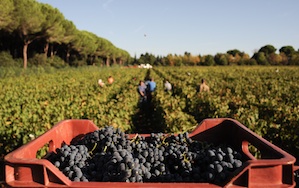The announcement that 11 premium Italian wine producers have formed the Italia del Vino-Consorzio and called for a co-ordinated campaign to “construct and enact a national strategy to attack emerging markets for wine” is excellent news for winemakers in Tuscany.
Although Italy is one of the largest producers of wine in the world, both the country overall and its various regions lack effective, proactive generic bodies to represent them, safeguard their interests and actively promote their wines. Bordeaux has the CIVB, Burgundy the BIVB, Chile, the Wines of Chile, California, its Wine Institute and New Zealand, the NZWG. Italy? Frankly, not much.
Chianti Classico has a consorzio but it appears to have limited funds to be effectively proactive. So the IdVC is potentially great news for Italian wine producers, sellers and lovers of its wines.
Of the 11 IdVC combatants, seven have interests in Tuscany: Gruppo Italiano Vini; Conti Serristori and Melini in Poggibonsi (Siena); Machiavelli in San Casciano; Val di Pesa (Florence); Banfi is the biggest Brunello di Montalcino producer and Zonin has the Castello d’Albola estate in the Chianti Classico area.
Producers of the so-called Super-Tuscan (see panel) wines command such high prices that they hardly need any assistance in selling their wines.
So, producers in premium regions such as Chianti Classico and Brunello di Montalcino can only be thrilled at the prospect of a co-ordinated campaign to “attack emerging markets for wine”.
Turning to the Chianti Classico, Silvia Fiorentini the consorzio’s marketing and communication manager, tells Drinks International: “Trends are going towards an easier drinkability of the wines, but in Chianti Classico’s the freshness which is given by the acidity, typical of Sangiovese-based wines, can enlighten the impact of alcohol level. So you could find wines with 14% of alcohol which are still easily drinkable.
“The consortium has been working for several years (through the ’80s and ’90s) on scientific research under the name project Chianti Classico 2000, studying planting densities, clones, cultivation techniques and other in order to give its producers the best suggestions to replant their vineyards. The result was a constant improvement in the quality of Chianti Classico wines,” she says.
“Chianti Classicos may have different styles and characteristics, but with a common denominator: they are all strictly linked and influenced by their terroir. This is what global consumers and buyers appreciate in our wines: their authenticity,” says Fiorentini.
After the domestic market, which takes about 22% of Black Rooster (Chianti Classico’s Gallo Nero seal), the US takes 28% and Germany 13%, followed by Canada, UK and Switzerland (source: Chianti Classico Consorzio).
Castello di Querceto owner Alessandro François says as far as his company is concerned: “The leading export countries are the US, Germany, South Korea and Russia. Generally these countries are seeking different varietals and blends – mostly Sangiovese in Europe and the US and Cabernet Sauvignon in the Far East.”




